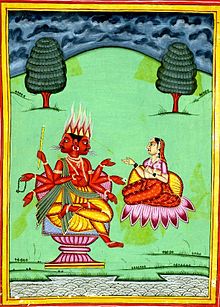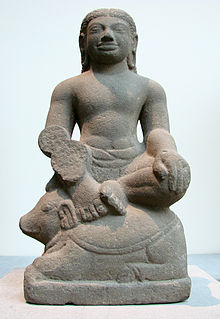- Agni
-
Agni 
God of Fire Devanagari अग्नि Sanskrit Transliteration Agni Affiliation Deva Consort Svaha Mount Ram Agni (Sanskrit: अग्नि) is a Hindu deity, one of the most important of the Vedic gods. He is the god of fire[1] and the acceptor of sacrifices. The sacrifices made to Agni go to the deities because Agni is a messenger from and to the other gods. He is ever-young, because the fire is re-lit every day, and also immortal.
Agni, the Vedic god of fire, has two heads, one marks immortality and the other marks an unknown symbol of life has made the transition into the Hindu pantheon of gods, without losing his importance. With Varuna and Indra he is one of the supreme gods in the Rig Veda. The link between heaven and earth, the deities and the humans, he is associated with Vedic sacrifice, taking offerings to the other world in his fire. In Hinduism, his vehicle is the ram.[2]
Contents
Etymology
The word agni is Sanskrit for "fire" (noun), cognate with Latin ignis (the root of English ignite), Russian огонь (ogon), Polish "ogień", and Lithuanian ugnis—all with the meaning "fire", with the reconstructed Proto-Indo-European root being h₁égni-. Agni has three forms: fire, lightning and the sun.[3]
In the Vedas
Wind Sea Fire Sky Earth
Air Water Aether Fire Earth
Hinduism (Tattva) and
Buddhism (Mahābhūta)Vayu Ap Akasha Agni Prithvi
Wood (木) Water (水) Earth (土) Fire (火) Metal (金)
Air (風) Water (水) Void (空) Fire (火) Earth (地)
Air Water Aether Fire Earth
Air Water Aether Fire Earth Sulphur Mercury Salt Agni is the first word of the first hymn of the Rigveda:
अग्नि॒म् ई॑ळे पुरो॒हि॑तं यज्ञ॒स्य॑ देव॒म् ऋत्वि॒ज॑म् । होता॑रं रत्नधा॒त॑मम् ॥
agním īḷe puróhitaṃ / yajñásya devám ṛtvíjam / hótāraṃ ratnadhâtamam
Agni I laud, the high priest, god, minister of sacrifice, The invoker, lavishest of wealth.He is the supreme director of religious ceremonies and duties, and figures as messenger between mortals and gods. Vedic rituals all involve Agni, for example the elaborate Agnicayana, that is, the piling of the fire altar, the Agnihotra, viz., offering to Agni.
The Rigveda often says that Agni arises from water or dwells in the waters. He may have originally been the same as Apam Napat, who is also sometimes described as fire arising from water which in a natural explanation may have referred to flames from natural gas or oil seepages surfacing through water. Other Rigvedic names, epithets or aspects of Agni include Matarishvan, Jatavedas, or Bharata.
Agni is a deva, second only to Indra in the power and importance attributed to him in Vedic mythology, with 218 out of 1,028 hymns of the Rigveda dedicated to him. He is Indra's twin, and therefore a son of Dyaus Pita and Prthivi. However, he is also said to have two mothers [4] (the two parts of the firedrill used to start the fire), and ten servant maids (the fingers of the man who is lighting the fire) or as the twice-born.[5] He is one of the Guardians of the directions, representing the southeast.
Agni, god of fire acts as the divine model for the sacrificial priest. He is the messenger who carries the oblation from humans to the gods, bringing the gods to sacrifice, and interceding between gods and humans (RgV.1.26.3). When Agni is pleased, the gods are generous. Agni represents the cultivated, cooked and cultured aspects of Vedic ritual. Together with Soma, Agni is invoked in the Rig Veda more than any other gods.[6]
In a later Hindu interpretation, Agni stands for knowledge for it is seen by the learned people, covering all things that move and do not move [7] and because it summons the Devatas endowed with knowledge [8] the light Agni emits is the light of knowledge. Therefore, it is also known as the illuminator of knowledge who lights up the path leading to Truth. Agni reveals the true nature of one's own self [9] because it is the innermost light that shines ever so brightly in all things living and nonliving as their inner consciousness (impeller).[10]
Depictions
In Hindu scriptures, Agni is depicted with two or seven hands, two heads and three legs. He has seven fiery tongues with which he licks sacrificial butter. He rides a ram or in a chariot harnessed by fiery horses. His attributes are an axe, torch, prayer beads and a flaming spear.[11]
Agni is represented as red and two-faced, suggesting both his destructive and beneficent qualities, and with black eyes and hair, three legs and seven arms. He rides a ram, or a chariot pulled by goats or, more rarely, parrots. Seven rays of light emanate from his body. One of his names is Saptajihva, "having seven tongues".[11] Another one of his epithets is Abhimani (from Sanskrit: abhi towards + the verbal root man to think, reflect upon) meaning dignified, proud; Longing for, thinking upon.
Legends
Agni is the eldest son of Brahma. In Visnu Purana, Agni (Abhimani) the fire god is said to have sprung from the mouth of the Virat purusha, the Cosmic Man. His wife is Svaha. Abhimani had three sons of surpassing brilliancy: Pavaka, Pavamana, and Suchi, the personifications of the three fires that produced our earth and humanity (VP 1:10).[12] All these three names indicate purity. Abhimanin, his three sons, and their 45 sons constitute the mystic 49 fires of the Puranas and theosophy. (cf Agni Purana.)
His three sons, according to the Vayu Purana, stand for three different aspects of Agni (fire): Pavaka is the electric fire, Pavamana the fire produced by friction, and Suchi the solar fire. Interpreted on the cosmic and human planes, these three fires are "Spirit, Soul, and Body, the three great Root groups, with their four additional divisions" (SD 2:247). They are said to have been cursed by the sage Vasishtha to be born again and again (cf BP 4:24,4; SD 2:247-8). "Every fire has a distinct function and meaning in the worlds of the physical and the spiritual. It has, moreover, in its essential nature a corresponding relation to one of the human psychic faculties, besides its well determined chemical and physical potencies when coming in contact with the terrestrially differentiated matter" (SD 1:521).
Agni is also an important entity in Ayurveda. It is considered to be the one which is responsible for the sustenance of life. Agni helps in the various physiological functions of the body.[citation needed]
In some Hindu symbolism, Agni's parents are said to be the two components of the firedrill used to start the fire, and when young he was said to be cared for by ten servants, which represent the fingers of the man who is starting the fire.
In other religions
In Newar, Tibetan and Japanese Buddhism, he is a lokapāla guarding the Southeast. Jigten lugs kyi bstan bcos: which translates, "Make your hearth in the southeast corner of the house, which is the quarter of Agni". He also plays a central role in most Buddhist homa fire-puja rites. A typical praise to Agni starts "Son of Brahma, Lord of the World, King of fire gods empowered by Takki, Whose supreme wisdom burns all delusion [...]" [13]
See also
- Apris
- Atar (Zoroastrian yazata of fire)
- Hindu deities
References
- ^ Mythology, An Illustrated Encyclopedia of the Principal Myths and Religions of the World, by Richard Cavendish ISBN 1-84056-070-3, 1998
- ^ Bowker, John. World Religions. New York: DK Publishing, Inc. 1997
- ^ Agni, the Vedic God of Fire
- ^ Ravinder Kumar Soni (2008). The Illumination of Knowledge. Delhi: GBD Books. p. 197. http://books.google.co.in/books?id=K2H_PgAACAAJ. "Rig Veda 1.31.2 - the term used is Dwimata shayuah "
- ^ Rig Veda 1.149.4 ibid p.43
- ^ Doniger, Wendy, The Hindus, an Alternative History, Oxford University Press, 2010, ISBN 978-0-19-959334 (Pbk)
- ^ Ravinder Kumar Soni (2008). The Illumination of Knowledge. Delhi: GBD Books. p. 197. http://books.google.co.in/books?id=K2H_PgAACAAJ. "Rig Veda 10.5.3"
- ^ Rig Veda 1.44.7 ibid p.42
- ^ Ravinder Kumar Soni (2008). The Illumination of Knowledge. Delhi: GBD Books. p. 214. http://books.google.co.in/books?id=K2H_PgAACAAJ. "Rig Veda 10.15.14- Meaning of the cited mantra :-"...these fatherly figures, the learned ones, who keep the fire alight at their homes and those who do not (who have renounced everything this world has to offer),owing to their knowledge of the highest Truth enjoy eternal happiness; the bright fire that burns within the as the very life principle giving them yogic powers...""
- ^ Ravinder Kumar Soni (2008). The Illumination of Knowledge. Delhi: GBD Books. p. 120. http://books.google.co.in/books?id=K2H_PgAACAAJ. "Rig Veda 10.57.2"
- ^ a b The Book of Hindu Imagery: Gods, Manifestations and Their Meaning By Eva Rudy Jansen p. 64
- ^ Google Books
- ^ A Manual of Ritual Fire offerings p20, Sharpa Tulku / Michael Perrott LTWA, 1987 ISBN 81-85102-66-X
Rigveda Mandalas Deities Rivers Rishis Saptarishi (Gritsamada · Vishvamitra · Vamadeva · Atri · Angiras · Bharadvaja · Vasishta)
Hindu deities and texts Gods 
Goddesses Texts Indian philosophy Texts Vedas (includes the Mukhya Upanishads) · Upanishads (Whole list...) · Puranas: Vishnu Purana, Bhagavata Purana · Ramayana · Mahabharata · Bhagavad-Gita · Buddhist texts · Jain AgamasTopics Āstika Samkhya · Nyaya · Vaisheshika · Yoga · Mimamsa · Vedanta (Advaita · Vishishtadvaita · Dvaita · Acintya bheda abheda)Nāstika Cārvāka · Ājīvika · Jaina (Anekantavada · Syadvada) · Bauddha (Shunyata · Madhyamaka · Yogacara · Sautrantika · Svatantrika)Philosophical
TextsYoga Sutra | Nyaya Sutra | Vaiseshika Sutra | Samkhya Sutra | Mimamsa Sutra | Brahma Sutra | More...Philosophers Akshapada Gotama | Patanjali | Yajnavalkya | Kanada | Kapila | Jaimini | Vyasa | Nagarjuna | Madhvacharya | Kumarajiva | Padmasambhava | Vasubandhu | Adi Shankara | Ramanuja | More...Categories:- Classical elements
- Fire gods
- Guardians of the directions
- Hindu gods
- Rigvedic deities
- Sanskrit words and phrases
- Solar gods
Wikimedia Foundation. 2010.


